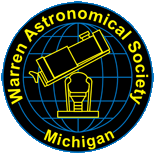| |||||||
 At the Observatory
At the Observatoryby Marty Kunz Now that the temperature has warmed up a bit, it's time for all of us fair weather observers to get out and do some observing. The number one excuse, THE BIG CHILL, is no longer valid. Likewise, if you don't have a telescope or if you have a new one but don't know how to use it, not a problem; come on out to the club's observatory, Stargate, which holds a 12.5 inch cassigrain telescope on equatorial mount. Each month Observatory Chairman Rick Gossett will hold an open house for members and non-members (this includes kids too). For the past two months [continued]  Astro Chatter
Astro Chatterby Larry Kalinowski The night of April 18 will give observers a chance to record the occultation of Aldebaran by the Moon. With a slender crescent showing, video cameras shouldn't have any trouble catching the star's disappearance behind the darkened limb about 11:15 PM EDT (3:15 UT). The Moon will be very low, about 10 degrees above the horizon with Venus near. The picture should be quite interesting if Aldebaran shows up in your video camera. Due to a fortunate set of circumstances, I've been able to purchase seven copies of SIRIUS, a planetarium program that will run in Windows 3.1, 95 or 98. The program comes complete on a floppy disk and includes an instruction manual for installation and operation. It's designed to be [continued]  Minutes of Meetings
Minutes of Meetingsby LoriAnn Skonieczny |
 New Members
New Membersby Joe Van Poucker The thing that makes the Warren Astronomical Society a great are its members. We are very happy to announce the following new members who joined during March of 1999. Please extend them a warm welcome.
 New Info
New Infoby Joe Van Poucker To All Sky & Telescope Magazine Subscribers: I received notice this month that the Club Discount Subscription Rates have gone up from $27.00 to $29.95. The new rate is in effect for all new and renewing subscriptions, however, any recently submitted subscriptions at the $27 rate will be accepted. I was also informed that if a member receives a renewal notice at the $27 rate it will be accepted as long as the renewal notice and payment is sent to Sky Publishing via the club's treasurer. In other News: I am still submitting a member's anniversaries column to the WASP. I am aware the club's membership info may be incorrect. If you see your name mentioned in the column and know that the info is incorrect please contact me so we can get the membership database updated. Clear Skies. |

